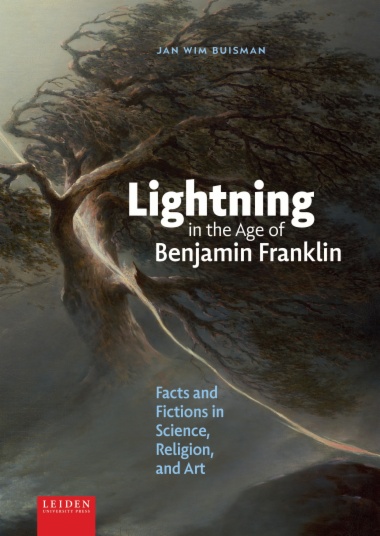Thunder and lightning have been seen from time immemorial as God’s instruments of punishment. Until the invention of the lightning rod by Benjamin Franklin in 1752. In Lightning in the Age of Benjamin Franklin. Facts and Fictions in Science, Religion, and Art Jan Wim Buisman shows how the Enlightenment and Romanticism have changed our scientific, religious and artistic image of natural violence forever. In the eighteenth century, thunderstorms are experienced less and less as a threat and more and more as something extraordinary. The image of God and the image of nature changed radically. The religion of enlightened people, for example, was more determined by joy than by fear. And nature was almost experienced as a girlfriend. That had significant consequences because those who no longer had to be afraid of the thunderstorm could play with it without hesitation. That’s what poets, painters and musicians did to their heart’s content. Never before the beauty of the storm was depicted as much in the western culture as during the transition from the Enlightenment to Romanticism.
- Table of contents
- Introduction: Lightning after Franklin
- Science and Technology
- 1. A New Invention
- 2. The Introduction of the Lightning Rod in the Netherlands
- Early Experiments and Publications (1745-1779)
- The First Installations
- Some Tentative Conclusions
- 3. Eighteenth-Century Physical Theories on Thunderstorms
- The International Discourse
- The Netherlands
- Conclusion: “Science” or “Superstition”?
- Religion
- 4. Official Religion
- God’s Wrath
- A Change in Mentality
- The Fatalism Controversy
- Protestant Enlightenment and Moderate Orthodoxy in the Netherlands
- Physico-Theology: The Netherlands
- Physico-Theology: Europe
- 5. Marginal and Marginalised Religious Reactions
- Thunderstorms: The Devil’s Work?
- Enlightenment’s Battle with Apotropaic Bell-Ringing
- Wetterschießen: Firing Cannon at Thunderclouds
- Beyond Demonology: the Cult of Saints
- Nature: Popular Beliefs and Agricultural Life
- 6. Intermezzo: Electrical Nature? The Animated Nature of Theosophy
- Art
- 7. Thunderstorms and Electricity in Poetry, Music, and Painting
- The Sexual Metaphor
- The Political Metaphor
- Metaphor for War, Violence, and Quarrel
- Metaphor for a Sparkling Mind or Tormented Inner Life
- From Metaphorising to Aestheticising
- By Way of Conclusion
- The Relationship between Fear, the Control of Nature, and Pleasure
- Epilogue
- Notes
- Bibliography
- Illustration Credits
- Index of Names�Index of Names

